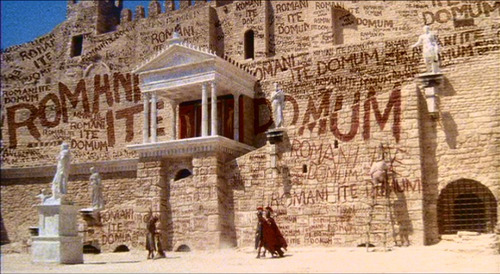Ancient 'Graffiti' Unlock the Life of Average People
http://www.sciencedaily.com/releases/20 ... 131640.htm
An ancient Greek graffito from Beth She'arim. (Credit: Image courtesy of American Friends of Tel Aviv University)
ScienceDaily (Mar. 6, 2012) — A professor of classics is translating and analyzing ancient inscriptions from columns, stones, tombs, floors, and mosaics of ancient Israel to uncover the life of the common men -- and women -- of antiquity.
History is often shaped by the stories of kings and religious and military leaders, and much of what we know about the past derives from official sources like military records and governmental decrees. Now an international project is gaining invaluable insights into the history of ancient Israel through the collection and analysis of inscriptions -- pieces of common writing that include anything from a single word to a love poem, epitaph, declaration, or question about faith, and everything in between that does not appear in a book or on a coin.
Such writing on the walls -- or column, stone, tomb, floor, or mosaic -- is essential to a scholar's toolbox, explains Prof. Jonathan Price of Tel Aviv University's Department of Classics. Along with his colleague Prof. Benjamin Isaac, Prof. Hannah Cotton of Hebrew University and Prof. Werner Eck of the University of Cologne, he is a contributing editor to a series of volumes that presents the written remains of the lives of common individuals in Israel, as well as adding important information about provincial administration and religious institutions, during the period between Alexander the Great and the rise of Islam (the fourth century B.C.E. to the seventh century C.E.).
These are the tweets of antiquity.
There has never been such a large-scale effort to recover inscriptions in a multi-lingual publication. Previous collections have been limited to the viewpoints of single cultures, topics, or languages. This innovative series seeks to uncover the whole story of a given site by incorporating inscriptions of every subject, length, and language, publishing them side by side. In antiquity, the part of the world that is now modern Israel was intensely multilingual, multicultural, and highly literate, says Prof. Price, who has presented the project at several conferences, and will present it again this fall in San Francisco and Philadelphia. When the volumes are complete, they will include an analysis of about 12,000 inscriptions in more than ten languages.
History's "scrap paper"
The project represents countless hours spent in museum storerooms, church basements, caves and archaeological sites, says Prof. Price, who notes that all the researchers involved have been dedicated to analyzing inscriptions straight from the physical objects on which they are written whenever possible, instead of drawings, photos or reproductions. The team has already discovered a great amount of material that has never been published before.
Each text is analyzed, translated, and published with commentary by top scholars. Researchers work to overcome the challenges of incomplete inscriptions, often eroded from their "canvas" with time, and sometimes poor use of grammar and spelling, which represent different levels in education and reading and writing capabilities -- or simply the informal nature of the text. Scholars thousands of years in the future might face similar difficulties when trying to decipher the language of our own text messages or emails.
Most of these inscriptions, especially the thousands of epitaphs, are written by average people, their names not recorded in any other source. This makes them indispensable for social, cultural, and religious history, suggests Prof. Price. "They give us information about what people believed, the languages they spoke, relationships between families, their occupations -- daily life," he says. "We don't have this from any other source."
The first volume, edited by Prof. Price, Prof. Isaac, and others and focusing on Jerusalem up to and through the first century C.E., has already been published. New volumes will be published regularly until the project comes to a close in 2017, resulting in approximately nine volumes.
"I was here"
Graffiti, which comprise a significant amount of the collected inscriptions, are a common phenomenon throughout the ancient world. Famously, the walls of the city of Pompeii were covered with graffiti, including advertisements, poetry, and lewd sketches. In ancient Israel, people also left behind small traces of their lives -- although discussion of belief systems, personal appeals to God, and hopes for the future are more prevalent than the sexual innuendo that adorns the walls of Pompeii.
"These are the only remains of real people. Thousands whose voices have disappeared into the oblivion of history," notes Prof. Price. These writings are, and have always been, a way for people to perpetuate their memory and mark their existence.
Of course, our world has its graffiti too. It's not hard to find, from subway doors and bathroom stalls to protected archaeological sites. Although it may be considered bothersome and disrespectful now, "in two thousand years, it'll be interesting to scholars," Prof. Price says with a smile.
Story Source:
The above story is reprinted from materials provided by American Friends of Tel Aviv University.



